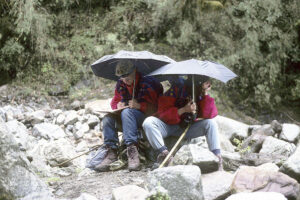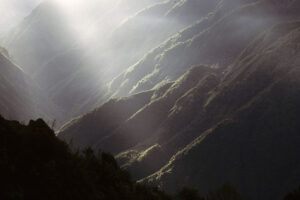Kaj Halberg - writer & photographer
Travels ‐ Landscapes ‐ Wildlife ‐ People
Nepal 1994: A close call

Drinking a cup of hot tea on an ice-cold morning, lying in your sleeping bag with your head sticking out of the tent to admire the gorgeous surrounding landscape, is something to relish!
The ground is covered by a thin blanket of snow, and there is a thin sheet of ice on the puddles. Small flocks of red-billed choughs (Pyrrhocorax pyrrhocorax) and snow pigeons (Columba leuconota) fly about over the grazing grounds, where numerous yak are grazing.
Grey smoke is rising from two stone houses, situated where a small tributary joins the roaring Ghunsa River. This is the home of two herders who look after the yak. Every morning, they milk the ones with calf.
Soon the sun appears, and the thin layer of snow rapidly vanishes. The marvellous morning weather is so inviting that Niels decides to shave off his three-day old stubble.
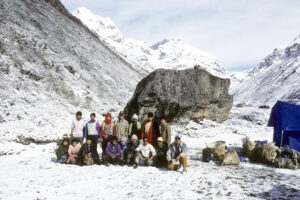

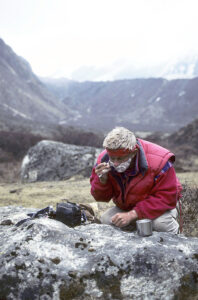
Following the riverbank, we make our way through shrubs of juniper (Juniperus), rhododendron, willow (Salix), and sea-buckthorn (Hippophaë rhamnoides). Quite a few passerines use these bushes, or rocks, as a look-out post, including robin accentor (Prunella rubeculoides), rufous-breasted accentor (P. strophiata), blue-fronted redstart (Phoenicurus frontalis), and beautiful rosefinch (Carpodacus pulcherrimus), whereas Brandt’s mountain-finches (Leucosticte brandti) are feeding in the grass among the bushes.
From the mountain slopes, we hear a penetrating call, gukka-gukka-guk-guk-guk-grrr. As it turns out, this is the morning call of the Tibetan snowcock (Tetraogallus tibetanus), a large, whitish gamebird, which is fairly common in alpine regions of Nepal.
We also observe many alpine choughs (Pyrrhocorax graculus), and a huge lammergeier (Gypaetus barbatus) glides effortlessly down the valley, looking for carcasses. It will probably cover the distance, which has taken us three days to walk, in less than an hour.
On our way, Helle begins to suffer from AMS (Acute Mountain Sickness), a condition caused by lack of oxygen in your body. We are walking at an altitude of 4,700 m, and the air contains less than two thirds of the amount of oxygen at sea level. In severe cases of AMS, you must descend, but as Helle’s case is rather mild, we choose to camp here and wait for a day. We see to it that she consumes a lot of water with various types of salt and sugar, which quickly makes her feel much better.
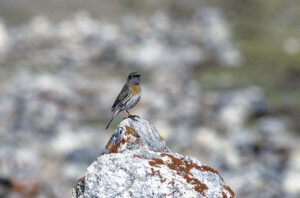
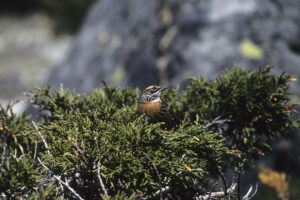
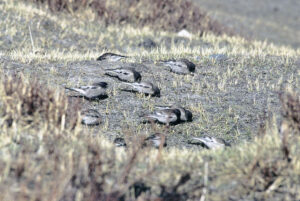
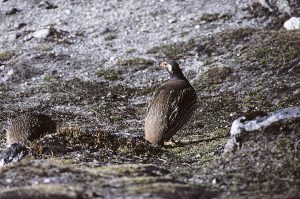
Around noon, the cloud cover lifts, revealing a very pretty, snow-clad landscape. Occasionally, sunbeams penetrate the clouds, which come and go. The evening light is fantastic, and throughout the night, we hear several avalanches, thundering down the slopes. The night is cold and clear, and in the morning, the grass is covered in rime.
During our hike towards Lhonak, the weather is indeed very pleasant. On our way, we pass a remarkable rock formation, called Shiva’s Finger. Shiva is among the three main gods in the Hindu pantheon, the other two being Brahma and Vishnu. These and other Hindu gods are described in depth on the page Religion: Hinduism.
On a slope, we spot a flock of foraging Himalayan blue sheep (Pseudois nayaur), called bharal in Hindi. This species is unique, as it is neither sheep nor goat, but shows behaviourial traits from both groups. The adult ram is a splendid animal, with massive, sweeping horns and a bluish-grey fur (hence its English name), with black markings on chest, flanks, and legs. Ewes and young animals are more uniformly grey.
In December, rams battle to gather a harem of ewes, but outside the rutting season, rams, ewes, and young form mixed flocks of varying size. Their main predators are snow leopard (Panthera uncia) and Asian black bear (Ursus thibetanus), and quite a few are killed by avalanches. This flock is rather confiding, and I manage to approach them to a distance of about 50 m.
The trail now follows the northern slopes of the valley, alongside the huge Kangchendzonga Glacier, most of which is covered in brownish-black moraine. Here and there, the shining ice is revealed, adding a green tinge to the numerous meltwater pools on the glacier.
As it turns out, Lhonak is a large grassy plain along the sandy banks of the Ghunsa River. Here, not far from Kangchendzonga (8586 m), the third-highest mountain in the world, we camp for the night.
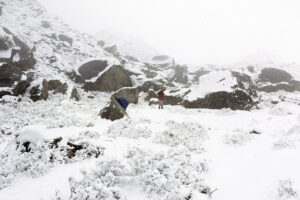

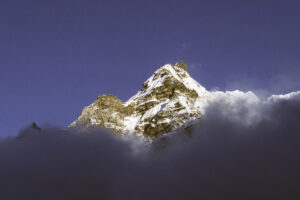

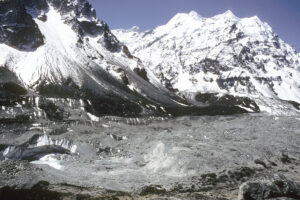
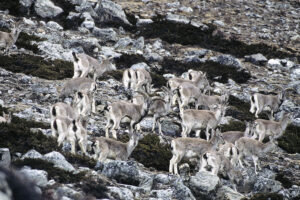
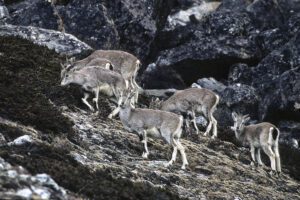
”Look out!” Dil suddenly shouts.
High above us, large blocks of ice have broken off, now thundering down the slope towards us. The majority are shattered on their way down, but some still measure several cubic feet. We run towards a couple of large rocks to seek shelter behind them, bits of ice flying around us. Miraculously, none of us are hit. Rather shaken, we continue our walk across several more landslides, mercifully without further mishap.
Again, on the following day, we must cross several landslides below Kambachen. Niels, Helle, and I are on our way across one of these, when numerous pebbles come tumbling down the slope towards us, followed by several larger rocks. We jump across the sliding gravel on the trail, I at the rear, pebbles and rocks flying around us.
Helle and Niels, who have taken shelter behind a huge rock, notice with horror that a larger rock is tumbling down the slope towards me, but luckily, at the very last moment, it hits a larger rock, changing its course. A close call, indeed!
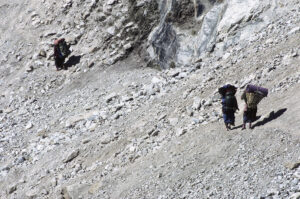
We camp in a lovely oak forest, where passerines abound, including black-faced laughing-thrush (Trochalopteron affine), bar-throated minla (Minla strigula), orange-gorgeted flycatcher (Ficedula strophiata), and golden-spectacled warbler (Seicercus burkii).
We also encounter a pair of green shrike-babblers (Pteruthius xanthochlorus), who are busy building a nest – a small pendent bag, hanging from a twig. The nest is made from lichens, mixed with thin roots, picked from an epiphyte, growing on a nearby rock. Incidentally, genetic research has revealed that the shrike babblers are not babblers, but probably related to the New World vireos, family Vireonidae.
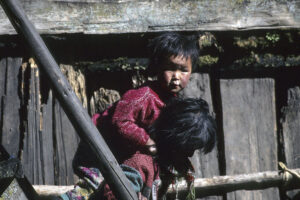
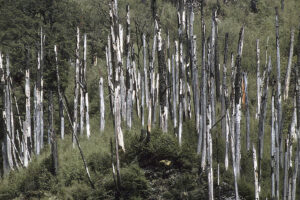
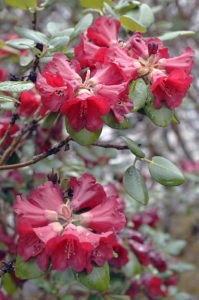
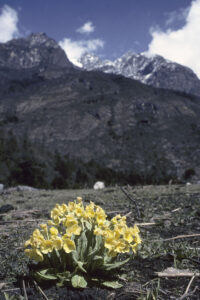
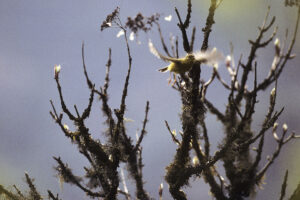
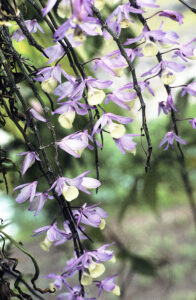
However, when we cross the long suspension bridge, spanning the Ghunsa River at Sekathum, the dog runs into problems. Being scared of the bridge, it attempts to swim across the river, but is washed downstream by the swift current. Luckily it manages to cling to a rock, howling in fear. Niels runs back across the bridge and out onto the rock, where he manages to get hold of the scruff of its neck, heaving it ashore and carrying it across the bridge.
For more than a week, the dog keeps us company, until some villagers persuade us to let them have it.
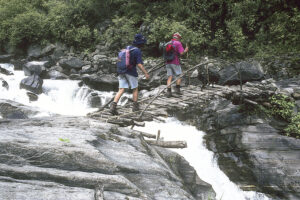
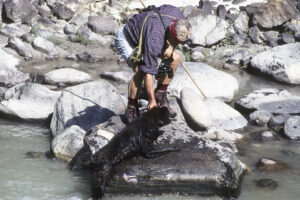
From Hellok, a steep trail leads up the mountain slope towards a ridge, Deorali Daara. When we finally reach the ridge, we are quite exhausted, but are rewarded with a wonderful view down the Tamur Valley. Atop the ridge, we encounter a beautiful herdswoman, who is guarding a flock of sheep. Her nose is adorned by a large golden trinket.
Following the ridge eastwards, we pass through a magnificent virgin forest – a tangle of old and young trees, whose trunks are covered in mosses, lichens and other epiphytes, and entwined by lianas. The forest floor is a dense jumble of dwarf bamboo, ferns, and various other plants. As bird life in this forest is very rich indeed, we decide to camp here a few days.
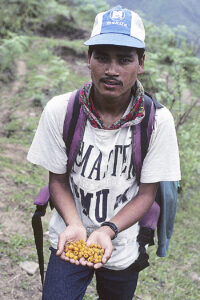
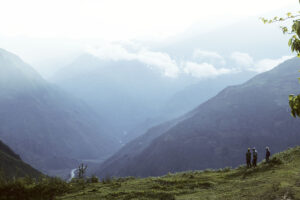
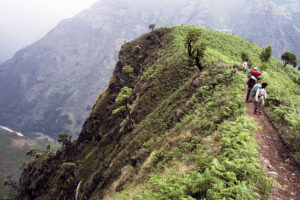
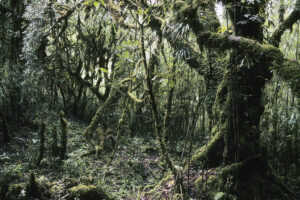
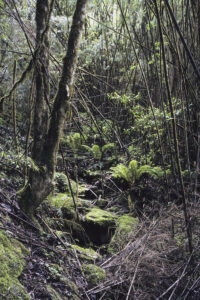
During our lunch break, we all seek shelter under a tarpaulin, with the exception of Niels and Helle, who are sitting under their umbrellas, Niels writing his diary.
Finally, the rain subsides, but the heavy downpours have caused the trail, which leads down into the Kabeli Valley, to become muddy and extremely slippery. We slide along, falling numerous times, but eventually reach a more pleasant trail, which follows a ridge.
The view across the valley is gorgeous, with small patches of sunshine moving across the valley floor.
